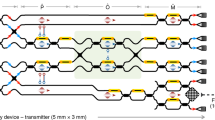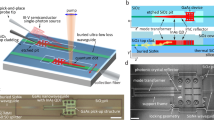Abstract
Large-scale integrated quantum photonic technologies1,2 will require on-chip integration of identical photon sources with reconfigurable waveguide circuits. Relatively complex quantum circuits have been demonstrated already1,2,3,4,5,6,7, but few studies acknowledge the pressing need to integrate photon sources and waveguide circuits together on-chip8,9. A key step towards such large-scale quantum technologies is the integration of just two individual photon sources within a waveguide circuit, and the demonstration of high-visibility quantum interference between them. Here, we report a silicon-on-insulator device that combines two four-wave mixing sources in an interferometer with a reconfigurable phase shifter. We configured the device to create and manipulate two-colour (non-degenerate) or same-colour (degenerate) path-entangled or path-unentangled photon pairs. We observed up to 100.0 ± 0.4% visibility quantum interference on-chip, and up to 95 ± 4% off-chip. Our device removes the need for external photon sources, provides a path to increasing the complexity of quantum photonic circuits and is a first step towards fully integrated quantum technologies.
This is a preview of subscription content, access via your institution
Access options
Subscribe to this journal
Receive 12 print issues and online access
$209.00 per year
only $17.42 per issue
Buy this article
- Purchase on Springer Link
- Instant access to full article PDF
Prices may be subject to local taxes which are calculated during checkout



Similar content being viewed by others
References
O'Brien, J. L., Furusawa, A. & Vuckovic, J. Photonic quantum technologies. Nature Photon. 3, 687–695 (2009).
Tanzilli, S. et al. On the genesis and evolution of integrated quantum optics. Las. Photon. Rev. 1, 115–143 (2012).
Peruzzo, A. et al. Quantum walks of correlated photons. Science 329, 1500–1503 (2010).
Shadbolt, P. J. et al. Generating, manipulating and measuring entanglement and mixture with a reconfigurable photonic circuit. Nature Photon. 6, 45–49 (2012).
Metcalf, B. J. et al. Multiphoton quantum interference in a multiport integrated photonic device. Nature Commun. 4, 1356 (2013).
Tillmann, M. et al. Experimental boson sampling. Nature Photon. 7, 540–544 (2013).
Crespi, A. et al. Anderson localization of entangled photons in an integrated quantum walk. Nature Photon. 7, 322–328 (2013).
Matsuda, N. et al. A monolithically integrated polarization entangled photon pair source on a silicon chip. Sci. Rep. 2, 817 (2012).
Martin, A., Alibart, O., DeMicheli, M. P., Ostrowsky, D. B. & Tanzilli, S. A quantum relay chip based on telecommunication integrated optics technology. New J. Phys. 14, 025002 (2012).
Soref, R. The past, present, and future of silicon photonics. J. Sel. Top. Quant. Electron. 12, 1678–1687 (2006).
Sun, J., Timurdogan, E., Yaacobi, A., Hosseini, E. S. & Watts, M. R. Large-scale nanophotonic phased array. Nature 493, 195–199 (2013).
Reed, G. T., Mashanovich, G., Gardes, F. Y. & Thomson, D. J. Silicon optical modulators. Nature Photon. 4, 518–526 (2010).
Bonneau, D. et al. Quantum interference and manipulation of entanglement in silicon wire waveguide quantum circuits. New J. Phys. 14, 045003 (2012).
Sharping, J. E. et al. Generation of correlated photons in nanoscale silicon waveguides. Opt. Express 14, 12388–12393 (2006).
Clemmen, S. et al. Continuous wave photon pair generation in silicon-on-insulator waveguides and ring resonators. Opt. Express 17, 16558–16570 (2009).
Takesue, H. et al. Generation of polarization entangled photon pairs using silicon wire waveguide. Opt. Express 16, 5721–5727 (2008).
Azzini, S. et al. Ultra-low power generation of twin photons in a compact silicon ring resonator. Opt. Express 20, 23100–23107 (2012).
Xiong, C. et al. Slow-light enhanced correlated photon pair generation in a silicon photonic crystal waveguide. Opt. Lett. 36, 3413–3415 (2011).
Garay-Palmett, K., U'ren, A., Rangel-Rojo, R., Evans, R. & Camacho-López, S. Ultrabroadband photon pair preparation by spontaneous four-wave mixing in a dispersion-engineered optical fiber. Phys. Rev. A 78, 043827 (2008).
Chen, J., Lee, K. F. & Kumar, P. Deterministic quantum splitter based on time-reversed Hong–Ou–Mandel interference. Phys. Rev. A 76, 031804(R) (2007).
Matthews, J. C. F., Politi, A., Stefanov, A. & O'Brien, J. L. Manipulation of multiphoton entanglement in waveguide quantum circuits. Nature Photon. 3, 346–350 (2009).
Rarity, J. G. & Tapster, P. R. Two-color photons and nonlocality in fourth-order interference. Phys. Rev. A 41, 5139–5146 (1990).
Ramelow, S., Ratschbacher, L., Fedrizzi, A., Langford, N. K. & Zeilinger, A. Discrete tunable color entanglement. Phys. Rev. Lett. 103, 253601 (2009).
Pittman, T. et al. Can two-photon interference be considered the interference of two photons? Phys. Rev. Lett. 77, 1917–1920 (1996).
Hong, C. K., Ou, Z. Y. & Mandel, L. Measurement of subpicosecond time intervals between two photons by interference. Phys. Rev. Lett. 59, 2044–2046 (1987).
Ou, Z. Y. & Mandel, L. Observation of spatial quantum beating with separated photodetectors. Phys. Rev. Lett. 61, 54–57 (1988).
Pan, J-W. et al. Multiphoton entanglement and interferometry. Rev. Mod. Phys. 84, 777–838 (2012).
Laing, A. et al. High-fidelity operation of quantum photonic circuits. Appl. Phys. Lett. 97, 211109 (2010).
Azzini, S. et al. Stimulated and spontaneous four-wave mixing in silicon-on-insulator coupled photonic wire nano-cavities. Appl. Phys. Lett. 103, 031117 (2013).
Yao, X.-C. et al. Observation of eight-photon entanglement. Nature Photon. 6, 225–228 (2012).
Yao, X.-C. et al. Experimental demonstration of topological error correction. Nature 482, 489–494 (2012).
Ma, X-S., Zotter, S., Kofler, J., Jennewein, T. & Zeilinger, A. Experimental generation of single photons via active multiplexing. Phys. Rev. A 83, 043814 (2011).
Mower, J. & Englund, D. Efficient generation of single and entangled photons on a silicon photonic integrated chip. Phys. Rev. A 84, 052326 (2011).
Gnan, M., Thoms, S., Macintyre, D., De La Rue, R. M. & Sorel, M. Fabrication of low-loss photonic wires in silicon-on-insulator using hydrogen silsesquioxane electron-beam resist. Electron. Lett. 44, 115–116 (2008).
Sheng, Z. et al. A compact and low-loss MMI coupler fabricated with CMOS technology. IEEE Photon. J. 4, 2272–2277 (2012).
Acknowledgements
We thank A. Politi for useful discussions, and F. Melloti for experimental assistance. This work was supported by the Engineering and Physical Science Research Council (UK), the European Research Council, the Bristol Centre for Nanoscience and Quantum Information, the European FP7 project QUANTIP and the European FP7 project BBOI. J.W.S. acknowledges support from the Natural Sciences and Engineering Research Council of Canada. R.H.H. acknowledges a Royal Society University Research Fellowship. V.Z. acknowledges support from the Dutch Foundation for Fundamental Research on Matter. G.D.M. acknowledges the FP7 Marie Curie International Incoming Fellowship scheme. J.L.O'B. acknowledges a Royal Society Wolfson Merit Award and a Royal Academy of Engineering Chair in Emerging Technologies. M.G.Th. acknowledges support from the Toshiba Research Fellowship scheme.
Author information
Authors and Affiliations
Contributions
J.W.S. and D.B. contributed equally to this work. J.W.S., D.B., J.G.R., J.L.O'B. and M.G.Th. conceived and designed the experiments. J.W.S., D.B. and M.G.Th. analysed the data. K.O., N.S., H.Y., N.I. and M.E. fabricated the device. R.H.H., V.Z., C.M.N. and M.G.Ta. built the single-photon detector system. J.W.S., D.B. and G.D.M. performed the experiments. J.W.S., D.B., G.D.M., J.G.R., J.L.O'B. and M.G.Th. wrote the manuscript.
Corresponding author
Ethics declarations
Competing interests
J.W.S., D.B., J.L.O'B. and M.G.Th. declare UK patent application number 1302895.6.
Supplementary information
Supplementary information
Supplementary information (PDF 718 kb)
Rights and permissions
About this article
Cite this article
Silverstone, J., Bonneau, D., Ohira, K. et al. On-chip quantum interference between silicon photon-pair sources. Nature Photon 8, 104–108 (2014). https://doi.org/10.1038/nphoton.2013.339
Received:
Accepted:
Published:
Issue Date:
DOI: https://doi.org/10.1038/nphoton.2013.339
This article is cited by
-
Prospects and applications of on-chip lasers
eLight (2023)
-
Fully on-chip photonic turnkey quantum source for entangled qubit/qudit state generation
Nature Photonics (2023)
-
Applications of single photons to quantum communication and computing
Nature Reviews Physics (2023)
-
Quantum frequency conversion and single-photon detection with lithium niobate nanophotonic chips
npj Quantum Information (2023)
-
Optofluidic memory and self-induced nonlinear optical phase change for reservoir computing in silicon photonics
Nature Communications (2023)



